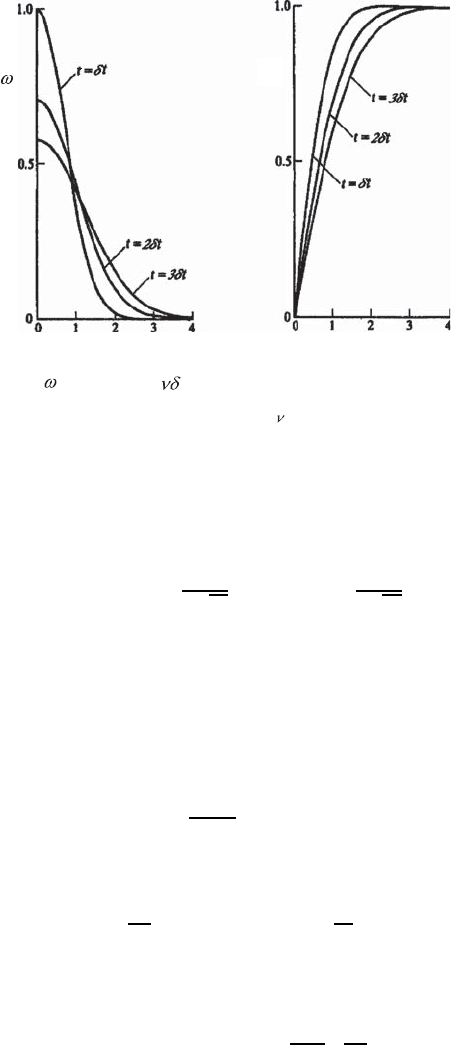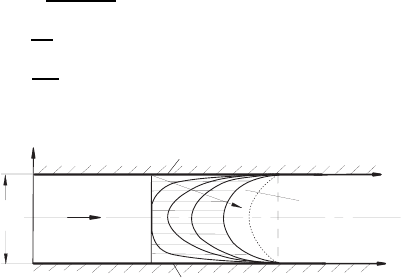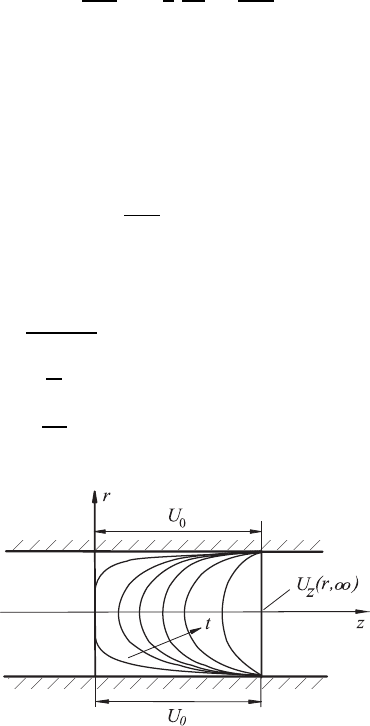Durst F. Fluid Mechanics: An Introduction to the Theory of Fluid Flows
Подождите немного. Документ загружается.


400 14 Time-Dependent Flows
The partial derivatives of η with respect to x
2
and t are given as:
∂η
∂x
2
=(νt)
−1/2
and
∂η
∂t
= −
η
2t
(14.46)
Therefore, one obtains
∂ω
∂t
= U
0
(νt)
−1/2
−
1
2t
f(η)+f
(η)
∂η
∂t
= −
U
0
2t
(νt)
−1/2
[f(η)+ηf
(η)]
(14.47)
∂ω
∂x
2
= U
0
(νt)
−1/2
f
(η)
∂η
∂x
2
= U
0
f
(η) (14.48)
∂
2
ω
∂x
2
2
= U
0
f
(η)
∂η
∂x
2
= U
0
(νt)
−1/2
f
(η) (14.49)
Introducing the equations (14.47) to (14.49) into the partial differential equa-
tion (14.43), one obtains the following ordinary differential equation for
f(η):
2f
+ ηf
+ f =2f
+(ηf)
= 0 (14.50)
By integrating this equation once, one obtains:
2f
+ ηf = C
1
(14.51)
The distribution of the vorticity is symmetrical with respect to x
2
, and thus
f
(η =0)=0holdsC
1
= 0. With this, (14.51) can be rewritten as follows:
2
df
dη
= −ηf ;
df
f
= −
η
2
dη = − d
η
2
4
(14.52)
Therefore, as a solution of this ordinary differential one obtains:
f(η)=C exp
−
η
2
4
(14.53)
With the following integration:
∞
#
0
ω dx
2
= −
∞
#
0
∂U
1
∂x
2
dx
2
= U
0
(14.54)
and setting ω into the above integral, one obtains
C =(π)
−1/2
(14.55)
Thus as a solution for ω one obtains
ω(x
2
,t)=U
0
(πνt)
−1/2
exp
−
x
2
2
νt
(14.56)

14.2 Accelerated and Decelerated Fluid Flows 401
∗
(a) Vorticity
=
(
Ω
/U
)(
4
t
)
∗
1/2
(b) Velocity
=
(
u/U
)
u
∗
u
∗
x
2
x
2
∗
∗
x = x
(
4
t
)
2
∗
2
0
-1/2
Fig. 14.2 Diffusion of vorticity and molecular momentum transport in the fluid as
a consequence of a moved plane plate
This solution corresponds to:
U
1
(x
2
,t)=U
0
1 − erf
x
2
2
√
νt
= U
0
erfc
x
2
2
√
νt
(14.57)
The diffusion of the vorticity, expressed by (14.56) is sketched in a normalized
form in Fig. 14.2 and the corresponding dimensionless velocity distribution
expressed by (14.57) is plotted next to it.
For the flow shown in Fig. 14.2, the following integral parameters can be
computed:
• Vorticity diffusion radius
δ
ω
=
2U
0
Ω
max
=(πνt)
1/2
(14.58)
• Displacement thickness of the flow
δ
1
=
2
U
0
∞
#
0
(U
0
− U
1
)dx
2
=
νt
π
1/2
(14.59)
• Momentum-loss thickness of the flow
δ
2
=
+∞
#
−∞
!
U
2
0
− U
2
1
"
dx
2
=
1
4U
2
0
νt
8π
1/2
(14.60)

402 14 Time-Dependent Flows
These final properties of the flow are usually employed to calculate the state
of the flow at a certain time.
14.2.3 Channel Flow Induced by Movements of Plates
In this section, a one-dimensional transient flow problem of an incompressible
fluid will be discussed, which cannot be solved with the help of the general
solution derived in Sect. 14.1, as this solution is unable to fulfil the bound-
ary conditions characterizing the flow problem sketched in Fig. 14.3. This
fact requires the derivation of another particular solution for the differential
equation characterizing the problem. It is additionally required that the new
solution can satisfy the predefined boundary conditions for the problem un-
der consideration. For this purpose, a solution path is taken which can be
obtained through the well-known Fourier analysis, as employed in the theory
of heat conduction. The flow problem discussed in this section will therefore
serve as an example to point out the application of this known method of
heat conduction in fluid mechanics.
Figure 14.3 shows schematically the flow problem to be solved. Two walls
are shown that are placed in a fluid. Both walls together form a plane channel
between themselves. For t<0 both walls are at rest, whereas they both
assume a velocity U
0
along the x
1
-axis for t ≥ 0. As a consequence of this,
a fluid movement is induced, which starts at both sides of the plates and
it moves inwards due to the fluid viscosity. For the problem treated in this
section, the fluid flow induced between the plates and its transient progress
will be discussed.
In order to obtain the solution of the general flow problem of plate-induced
channel flow, the introduction of the following dimensionless quantities is
recommended:
U
∗
=
U
0
− U
1
U
0
dimensionless velocity
η =
x
2
D
dimensionless position coordinate
τ =
νt
D
2
dimensionless time
U
0
x
2
x
1
2D
U
0
Induced fluid
t
Plane plate 1
Plane plate 2
Fig. 14.3 Fluid flow induced by the movement of the walls of a plane channel

14.2 Accelerated and Decelerated Fluid Flows 403
The partial differential equation:
∂U
1
∂t
= ν
∂
2
U
1
∂x
2
2
(14.61)
describing the flow problem can thus be written:
−
νU
0
D
2
∂U
∗
∂τ
= −ν
U
0
D
2
∂
2
U
∗
∂η
2
or
∂U
∗
∂τ
=
∂
2
U
∗
∂η
2
(14.62)
The initial condition expressed in dimensionless quantities:
τ =0,U
∗
(η) = 1 (14.63)
and the boundary conditions at the walls:
η = ±1,U
∗
(η = ±1) = 0 (14.64)
and also the demand for symmetry at the center line of the channel:
η =0,
∂U
∗
∂η
= 0 (14.65)
define the flow problem sketched in Fig. 14.3.
For the solution of the partial differential equation (14.62), there is a classi-
cal solution path, which is based on the method of separation of the variables,
i.e. the solution is sought with an ansatz of the following form:
U
∗
(η, τ)=f(η)g(τ) (14.66)
From this, it follows that the left-hand side of (14.62) can be expressed as:
∂U
∗
∂τ
= f
dg
dτ
(14.67)
and for the right-hand side:
∂
2
U
∗
∂η
2
= g
d
2
f
dη
2
(14.68)
The expressions in (14.67) and (14.68) are inserted into the partial differential
equation (14.62) to yield:
1
g
dg
dτ
=
1
f
d
2
f
dη
2
= −λ
2
(14.69)
As the left-hand side of this ordinary differential equation depends only on
the variable τ and the right-hand side only on the variable η, the equation

404 14 Time-Dependent Flows
can only be fulfilled when both sides are set equal to a constant which is
introduced into (14.69) as −λ
2
.
The following ordinary differential equations thus result from (14.69) for
the function g:
dg
dτ
= −λ
2
g (14.70)
and the equation for f reads:
d
2
f
dη
2
= −λ
2
f (14.71)
The general solutions of these differential equations are obtained by
integrations as:
g = A exp(−λ
2
τ) (14.72)
f = B(cos λη)+C(sin λη) (14.73)
where A, B and C are integration constants. Applying the symmetry of the
solution, demanded in (14.65) to the above solutions, one obtains C =0,as
the sine function is unable to fulfil the requirement of symmetry at η =0.
Applying the second boundary condition (14.64), one obtains:
B(cos λ) = 0 (14.74)
In order to permit now a non-trivial solution of the flow problem, i.e. a solu-
tion that is different from zero, it is necessary that B = 0, i.e. the introduced
quantity λ can only assume some specific values such that (14.74) fulfils the
boundary conditions. Thus one obtains:
λ =
n +
1
2
π for n =0, ±1, ±2, ±3 ... (14.75)
In this way, the general solution of the problem, which fulfils the boundary
conditions of the flow problem, results as:
U
∗
n
= A
n
B
n
exp
3
−
n +
1
2
2
π
2
τ
4
cos
n +
1
2
πη
(14.76)
Since the governing differential equation is linear, one obtains the most
general solution as the sum of the individual solutions stated in (14.76):
U
∗
=
∞
n→−∞
A
n
B
n
exp
3
−
n +
1
2
2
π
2
τ
4
cos
n +
1
2
πη
5
(14.77)
Considering the symmetry of all n functions around n = 0 in the sum (14.77),
the solution can be written as:

14.2 Accelerated and Decelerated Fluid Flows 405
U
∗
=
∞
n=0
D
n
exp
3
−
n +
1
2
2
π
2
τ
4
cos
n +
1
2
πη
(14.78)
In this expression, D
n
= A
n
B
n
+ A
−(n+1)
B
−(n+1)
is an integration constant
which assumes a different value for each value of n. These values can be
determined from the initial condition (14.63):
1=
∞
n=0
D
n
cos
n +
1
2
πη
(14.79)
Multiplying (14.79) by
cos
m +
1
2
πη
dη
and integrating both sides from η = −1toη = +1, i.e. carrying out the
following integration:
+1
#
−1
cos
m +
1
2
πη
dη =
∞
n=0
D
n
+1
#
−1
cos
m +
1
2
πη
cos
n +
1
2
πη
dη
(14.80)
one obtains on the right-hand side for all n-values being always zero, when
m = n.Form = n the integration on both sides yields the following
conditional equation for D
m
:
3
sin
!
m +
1
2
"
πη
!
m +
1
2
"
π
4
+1
−1
= D
m
3
1
2
!
m +
1
2
"
π +
1
4
sin
!
m +
1
2
"
2πη
!
m +
1
2
"
π
4
+1
−1
or D
m
=
2(−1)
m
!
m +
1
2
"
π
⇒ D
n
=
2(−1)
n
!
n +
1
2
"
π
(14.81)
With this conditional equation for D
n
one obtains the final relation for the
plate induced transient channel flow:
U
∗
=2
+∞
n=0
(−1)
n
!
n +
1
2
"
π
exp
3
−
n +
1
2
2
π
2
τ
4
cos
n +
1
2
πη
(14.82)
or in terms of the dimensional quantities:
U
1
= U
0
− 2U
0
∞
n=0
(−1)
n
!
n +
1
2
"
π
exp
3
−
n +
1
2
2
π
2
νt
D
2
4
cos
n +
1
2
π
x
2
D
(14.83)
The above infinite series has the property of converging very quickly when
the dimensionless time (νt/D
2
) is large. On the other hand, the convergence
is slow when (νt/D
2
) is small. Considering the derived solution (14.83) for
(νt/D
2
) → 0, the result is in agreement with the solution of the plate-induced

406 14 Time-Dependent Flows
1
1
1
1
1
1
Fig. 14.4 Computed velocity distribution in the flow as a function of location and
time
fluid movement treated in Sect. 4.3.2. By employing Laplace transformation
for small dimensionless times, the employment of (14.37) can be recom-
mended for the computation of the velocity distribution in the channel. This
relationship has to be applied to both halves of the channel and the different
positions of the coordinate systems in Figs. 14.1 and 14.3 have to be taken
into consideration.
In Fig. 14.4, a graphical representation is given for the velocity distribution
described by the final equation (14.83). This representation shows that, for
small dimensionless times (νt/D
2
), only the fluid layers between the plane
plates of Fig. 14.3 near the wall are moved. Likewise, only for a dimensionless
time (νt/D
2
) ≥ 0.04 is a perceivable movement of the fluid in the middle of
the channel obtained. For (νt/D
2
) ≥ 1, almost the entire fluid in the space
between the plates has reached the plate velocity U
0
.For(νt/D
2
) →∞,the
entire fluid moves between the plates with the velocity U
0
.
On considering the final state of the plate-induced channel flow for
(νt/D
2
) →∞, one recognizes that it no longer depends on time, i.e. one
should be able to compute it also by solving the partial differential equation
for stationary, one-dimensional flows. The partial equation and its solution
read
µ
∂
2
U
1
∂x
2
2
=0 ⇒ U
1
= C
1
x
2
+ C
2
(14.84)
Applying the boundary conditions U
1
= U
0
for x
2
= ±D to this solution,
one obtains
C
1
=0 and C
2
= U
0
(14.85)
and thus U
1
= U
0
is obtained for plane plate-induced channel flow for
(νt/D
2
) →∞. This solution shows that for the characteristic time of this

14.2 Accelerated and Decelerated Fluid Flows 407
flow problem to go to infinity, all fluid moves at the constant plate velocity;
the entire fluid is swept along by the plates.
14.2.4 Pipe Flow Induced by the Pipe Wall Motion
Analogous to the flow between two plates discussed in Sect. 14.2.3, which
was caused by the movement of the plate walls, the pipe flow can also be
treated, which is brought about by the movement of the pipe wall as sketched
in Fig. 14.5. The basic equation to this problem is the partial differential
equation derived from (14.28) where only the first term on the right-hand
side is considered:
∂U
z
∂t
= ν
1
r
∂
∂r
r
∂U
z
∂r
(14.86)
The flow problem to be studied with this equation can be defined by the
following initial and boundary conditions:
initial condition U
z
(r, t =0)=0 for0≤ r ≤ R (14.87)
boundary condition U
z
(R, t)=U
0
moving wall
for all times t ≥ 0 (14.88)
∂U
z
∂r
(0,t) = 0 symmetry (14.89)
Analogous to the treatment of the channel flow, induced by the movements
of the walls, the following dimensionless quantities are introduced:
U
∗
=
U
0
− U
z
U
0
dimensionless velocity (14.90)
η =
r
R
dimensionless position coordinates (14.91)
τ =
νt
R
2
dimensionless time (14.92)
Fig. 14.5 Fluid flow in a pipe induced by the motion of the pipe walls

408 14 Time-Dependent Flows
Thus the differential equation (14.86) can be written in dimensionless
quantities as follows:
−ν
U
0
R
2
∂U
∗
z
∂τ
= −ν
U
0
R
2
1
η
∂U
∗
z
∂η
+
∂
2
U
∗
z
∂η
2
(14.93)
∂U
∗
z
∂τ
=
1
η
∂U
∗
z
∂η
+
∂
2
U
∗
z
∂η
2
(14.94)
The following initial condition for the dimensionless velocity results:
τ =0 U
∗
(η) = 1 (14.95)
and boundary conditions can be given for all times t ≥ 0 as follows:
η =1 U
∗
= 0 (14.96)
and
η =0
∂U
∗
∂η
= 0 (14.97)
Again, the classical solution path can be chosen with the ansatz that the
variables can be separated:
U
∗
(η, τ)=f(η)g(τ) (14.98)
With the substitution of this ansatz into the differential equation (14.94),
one obtains:
f
dg
dτ
=
g
η
df
dη
+ g
d
2
f
dη
2
(14.99)
As g depends only on τ and f only on η, by separation of variables the
following ordinary differential equations for g and f result:
1
g
dg
dτ
= − λ
2
(14.100)
1
η
1
f
df
dη
+
1
f
d
2
f
dη
2
= − λ
2
(14.101)
The solution for the differential equation (14.100) can be derived by
integration:
g = C
1
exp(−λ
2
τ) (14.102)
In order to determine the solution of the differential equation for f (η),
(14.101) can be written as follows:
d
2
f
dη
2
+
1
η
df
dη
+ λ
2
f = 0 (14.103)

14.2 Accelerated and Decelerated Fluid Flows 409
From rewriting of (14.103), a Bessel differential equation results:
η
2
d
2
f
dη
2
+ η
df
dη
+ λ
2
η
2
f = 0 (14.104)
and with
α = λη (14.105)
one obtains
α
2
d
2
f
dα
2
+ α
df
dα
+ α
2
f = 0 (14.106)
This equation has the following general solution:
f(α)=C
2
J
0
(α)+C
3
Y
0
(α) (14.107)
The solution for J
0
results from the Bessel differential equation:
x
2
y
(x)+xy
(x)+(x
2
− p
2
)y(x) = 0 (14.108)
which plays an essential role in many fields of theoretical physics and which
has the solution
J
p
(x)=
∞
n=0
(−1)
n
Γ (n +1)Γ (n + p +1)
x
2
2n+p
(14.109)
where the Γ -function is defined as follows:
Γ (n)=
∞
#
0
exp (−x) x
n−1
dx for n>0 (14.110)
and can also be determined, for non-discrete values of n,byintegral
arguments.
The function J
p
(x) is defined as being a Bessel function of the first kind
and of order p.
The second function required for the complete solution of the Bessel dif-
ferential equation of zero order (14.106) is the Bessel function of the second
kind, but also of zero order, i.e. Y
0
(α). This function is often also called the
Neumann or Weber function. Thus the solution ansatz (14.107) in terms of
J
0
(α)andY
0
(α) is composed of the Bessel functions of first and second kinds
and of zero order.
Considering the symmetry boundary condition in (14.97) or, noting that
at η =0,Y
0
(λη) →∞, one finds C
3
= 0 in (14.107). Therefore, the solution
for U
∗
, substituting α = λη, may be written as
U
∗
(η, τ)=C
1
exp(−λ
2
τ)J
0
(λη)=A exp(−λ
2
τ)J
0
(λη) (14.111)
